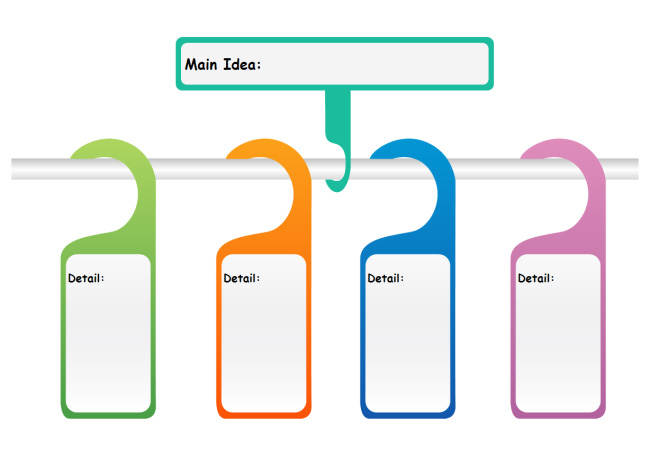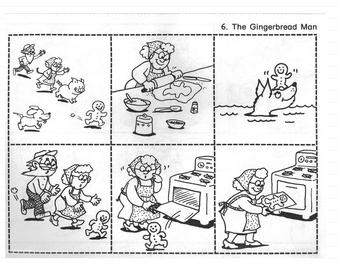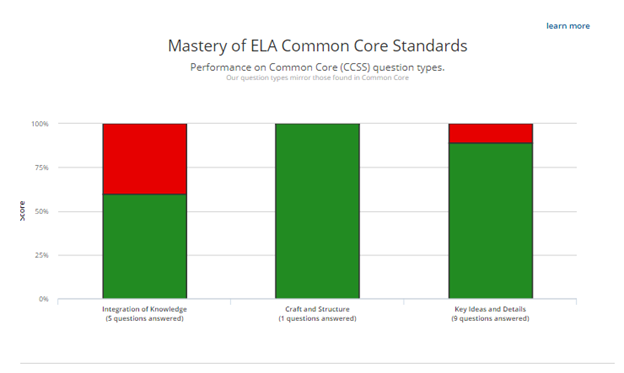Getting students to stop decoding and to start comprehending
When students start school, they learn the building blocks of reading: phonemic awareness, blending, fluency, and vocabulary. Now it’s time for the big leap to comprehension. As students transition from the building blocks of word recognition to the building blocks of comprehension, it is important to remember that none of the skills should be viewed in isolation–they are all interconnected.
Where to start: The comprehension skill web
As readers develop, there is a progression of skills from concrete to abstract: main idea, key details, sequencing, summarizing, cause and effect, predicting (activating prior knowledge), and inferences. But don’t think of this as a linear progression; the skills are all interrelated. Think more of a web than a staircase. Each strand is connected and supports the other parts.

Skill 1: Main Idea and Key Details
Main idea is the natural beginning of assessing reading comprehension by asking what the passage was about. Start with asking, “What does the author want us to know about this topic?” Identify the main idea and that logically brings in the next step: key details. Key details are again fact-based on what is read. This is one of the areas that ReadTheory assesses. It provides an accuracy score which can be used to determine mastery at the student’s instructional level.
Strategies and Resources:
- Main Idea: Start with the “wh” words. The who, what, where, when, and why of a passage. Here’s a basic template from ReadTheory.org. https://readtheory.org/wp-content/uploads/2020/12/Summarizing-Handout.pdf

- Key Details support the main idea. This is a little trickier than just pulling out the facts. There has to be a correlation between the main idea and the key details. Graphic organizers are a great visual representation. I particularly like this one because it shows the main idea and “hangs” the key details on the main idea rod. This and other free templates can be found here:
https://www.chartstemplates.com/anchor-chart/hanger-main-idea-details/

Skill 2: Sequencing and Summarizing

A colleague and I had a discussion recently about which comes first: sequencing or summarizing. We came to the conclusion that sequencing leads to more organized summarizing. Sequencing is organizing a passage into the beginning, middle and end. Summarizing is bringing those parts of the story together to briefly retell what has been read.
Strategies and Resources:
- Using a cartoon template is an engaging way to organize a story into its beginning, middle, and end. A cut and paste activity may be appropriate for younger students or a story map can be used with older students. Here is an example from this website: https://spedellreadingstrategies.weebly.com/sequencing.html

- After the passage is summarized, transition words can be utilized to turn the sequence of events into a summary. Here is a link to a free worksheet that combines sequencing and summarizing: https://readtheory.org/wp-content/uploads/2020/12/Sequencing-Handout-1.pdf

- For more advanced students, here is a link to more advanced transition words: https://www.readingrockets.org/content/pdfs/transition%20words.pdf
Skill 3: Cause and Effect

Up to this point, the reading strategies have focused on concrete information: the who, the what, and the order of the events. To enhance reading comprehension, the next steps are to take the information presented to determine correlations and relationships between what is read and what is inferred. “Reading between the lines” so to speak. Cause and effect is not always directly explained in a text. This can be confusing for some students because the story does not always unfold in a linear way. The story could begin with the effect and a student would have to keep reading to determine the cause(s).
Strategies and Resources:
- Signal words. I always tell my students to identify the effect first: “What happened?” Then fill in this sentence: The ________happened BECAUSE _____________. The “because” is the cause. This is not as simple as it sounds for some readers. For some readers this may need to be broken down by using single sentences for practice before moving on to longer passages. i. e., Matt got soaking wet because he forgot his umbrella. Effect: Matt got wet. Cause: He didn’t have his umbrella. (This also requires an inference that it rained.)
- Anchor charts. An example of an anchor chart can be found here along with other strategies for teaching cause and effect. https://rockinresources.com/2016/09/7-ways-to-teach-cause-and-effect.html
Skill 4: Predicting and Inferences

Making predictions is the precursor to inferences. While predicting can simply be a guess it’s important to push students to activate their previous knowledge and to look for evidence. This is crucial because when a student can identify evidence in context, the student can begin to use textual evidence to support his/her answers. I usually teach these together and model them continually while engaging with a text by simply asking, “What will happen next?”, waiting for a response, and then pushing them with a “Why do you think that?”
Strategies and Resources:
- Making predictions can begin before the text is even read. Demonstrate how to make predictions by doing a “Think Aloud” with your class. To do this, say what you’re thinking by analyzing the title, heading, pictures or illustrations to predict the subject of the selection that will be read.
- Show photos or illustrations and ask the students to predict what will happen next.

- More prediction strategies can be found here: https://www.classroomnook.com/blog/predicting
- This website has a free graphic organizer and other great suggestions for further practice, including a link to classroom riddles–a fun way to practice inference skills. https://www.literacyideas.com/teaching-inference
A Side Note about Read Theory and Progress Monitoring:
Read Theory provides cumulative data about the students’ reading progress. Because the data is cumulative, I keep a spreadsheet where I record data “snapshots” as the students progress through the passages. Every two weeks, I record the average grade and lexile level, and the scores in the three Common Core areas that Read Theory measures: Key Ideas and Details, Integration of Knowledge, and Craft & Structure. I use this information to take a deeper dive into the grade and lexile levels of the passages read during that time frame to identify trends that may need to be addressed.

Next Steps: Embrace the spiral

While there is a natural progression of skills that build upon one another, these skills should not be taught in isolation from one another. They are all part of the big picture which is improving reading comprehension skills in your students.
Reading comprehension can and should be taught using a Spiral Curriculum. Students benefit from the repetition of learning material over time. Each time a topic is revisited, the information is reinforced and solidified. There are many different ways to incorporate these skills into more isolated practice. Of course, readers at different ages and levels have different needs. Elementary students, high-school students, ESL students, and SPED students may require specialized instruction to meet their own unique needs. To take a deeper dive to see what has worked for other teachers, check out this article: Teaching Reading Comprehension: Strategies & Tips From Real Teachers. https://readtheory.org/teaching-reading-comprehension-strategies-tips/
Read Theory provides great individualized practice for students. But if you want to teach or model the strategies, Read Theory’s Reading Comprehension printable worksheets and tests (https://readtheory.org/reading-comprehension-worksheets/ ) are a great resource to use. You can select worksheets by grade level (as measured by Read Theory’s pretest). These can be used to demonstrate and practice the skills in whole class or small group instruction.
No matter where your students are starting from, focusing on these key skills and continually circling back will ensure that they are able to move forward and grow as a reader and thinker.




6 replies on “The Four Comprehension Skills Every Student Needs”
You listed some great resources. Thanks so much! I’ve been a fan of RT for years!
They are great strategies. Thank you for helping us!
This is fantastic!
Dear Jana My son is 18, ASDHF. He can read anything. The comprehension and answering is the “problem.” He keeps regressing back to a grade 1 level. The highest he has reached is grade 4. I don’t know if he is purposely tanking his passages or if there is a genuine misunderstanding of what is required. How should I address this with him?
Kind regards
Lynn
If you believe he is purposefully tanking on passages, you may want to use one of the security features we have in place on the site to your advantage. Our site will never assign a student a passage that is more than 3 levels below their highest achieved level. So if you logged in as your son and answered quizzes correctly until he advanced to the 6th grade level, he could never again see passages below grade 3. If he struggled on those passages at that point, it may be that he earnestly was struggling with more complex passages. In that case, contact ReadTheory support and they’ll reset his progress. This will start him over from the pretest and allow the program to once again offer lower-level passages.
If you have additional questions, please reach out to support@readtheory.org directly and they’ll help out!
Hi Lynn! I have some questions for you. Have you looked at the types of questions your son is consistently missing? In my experiences with ASD students, I have noticed that they struggle more with the craft and structure questions as those questions require higher level reading skills such as making inferences and determining the meaning of unknown words used in context. Another type of question that my students will just guess at is “Which one is NOT…” They never want to take the time to look back into the passage to verify the true statements. You can take a deeper dive into the passages where your son did not score well to see the types of questions he is missing by clicking on the name of the passage. I’m not sure what parents can access, but the folks at Read Theory can help you (support@readtheory.org) Coincidentally, my next article is about strategies to improve craft and structure skills. Stay tuned!